UBS Axcera LU1000AT 1000-Watt UHF Transmitter User Manual 379391
UBS-Axcera 1000-Watt UHF Transmitter 379391
Contents
- 1. Title Page Exciter
- 2. Table of Contents Exciter
- 3. Chapter 1 Exciter
- 4. Chapter 2 Exciter
- 5. Chapter 3 Exciter
- 6. Chapter 4 Exciter
- 7. Chapter 5 Exciter
- 8. Appendix Pages Exciter
- 9. Data Sheet Exciter and Amplifier
- 10. Drawings List Exciter
- 11. Title Page External Amplifier
- 12. Table of Contents External Amplifier
- 13. Chapter 1 External Amplifier
- 14. Chapter 2 External Amplifier
- 15. Chapter 3 External Amplifier
- 16. Chapter 4 External Amplifier
- 17. Chapter 5 External Amplifier
- 18. Appendix Pages External Amplifier
- 19. Drawings List External Amplifier
Chapter 3 External Amplifier

LX Series Power Amplifier Assembly Chapter 3, Site Considerations,
Installation and Setup Procedures
LX Series, Rev. 0 3-1
Chapter 3
Site Considerations, Installation and Setup Procedures
There are special considerations that
need to be taken into account before the
LX Series Power Amplifier Assembly and
exciter/driver assembly can be installed.
For example, if the installation is
completed during cool weather, a heat-
related problem may not surface for
many months, suddenly appearing during
the heat of summer. This section
provides planning information for the
installation and set up of the transmitter.
3.1 Site Considerations
The transmitter requires an AC input line
of 220 VAC @ 5 amps for the Driver
Assembly and an AC line for each 500
Watt Amplifier Assembly of 220 VAC @
17 amps maximum.
The LX Series Transmitters are designed
and built to provide long life with a
minimum of maintenance. The
environment in which they are placed is
important and certain precautions must
be taken. The three greatest dangers to
the transmitter are heat, dirt, and
moisture. Heat is usually the greatest
problem, followed by dirt, and then
moisture. Over-temperature can cause
heat-related problems such as thermal
runaway and component failure. Each
amplifier module in the transmitter
contains a thermal interlock protection
circuit that will shut down that module
until the temperature drops to an
acceptable level.
A suitable environment for the
transmitter can enhance the overall
performance and reliability of the
transmitter and maximize revenues by
minimizing downtime. A properly
designed facility will have an adequate
supply of cool, clean air, free of airborne
particulates of any kind, and no
excessive humidity. An ideal environment
will require temperature in the range of
40° F to 70° F throughout the year,
reasonably low humidity, and a dust-free
room. It should be noted that this is
rarely if ever attainable in the real world.
However, the closer the environment is
to this design, the greater the operating
capacity of the transmitter.
The fans are designed and built into the
transmitter will remove the heat from
within the modules, but additional means
are required for removing this heat from
the building. To achieve this, a few issues
need to be resolved. The first step is to
determine the amount of heat to be
removed from the transmitter room.
There are generally three sources of heat
that must be considered. The first and
most obvious is the heat from the
transmitter itself. This amount can be
determined for a 100W transmitter by
subtracting the average power to the
antenna (69.5 watts) from the AC input
power (675 watts) and taking this
number in watts (605.5) and then
multiplying it by 3.41. This gives a result
of 2,065, the BTUs to be removed every
hour. 12,000 BTUs per hour equals one
ton. Therefore, a 1/4-ton air conditioner
will cool a 100W transmitter.
The second source of heat is other
equipment in the same room. This
number is calculated in the same way as
the equation for BTUs. The third source
of heat is equally obvious but not as
simple to calculate. This is the heat
coming through the walls, roof, and
windows on a hot summer day. Unless
the underside is exposed, the floor is
usually not a problem. Determining this
number is usually best left up to a
qualified HVAC technician. There are far
too many variables to even estimate this
number without reviewing the detailed
drawings of the site that show all of the
construction details. The sum of these
three sources is the bulk of the heat that
must be removed. There may be other
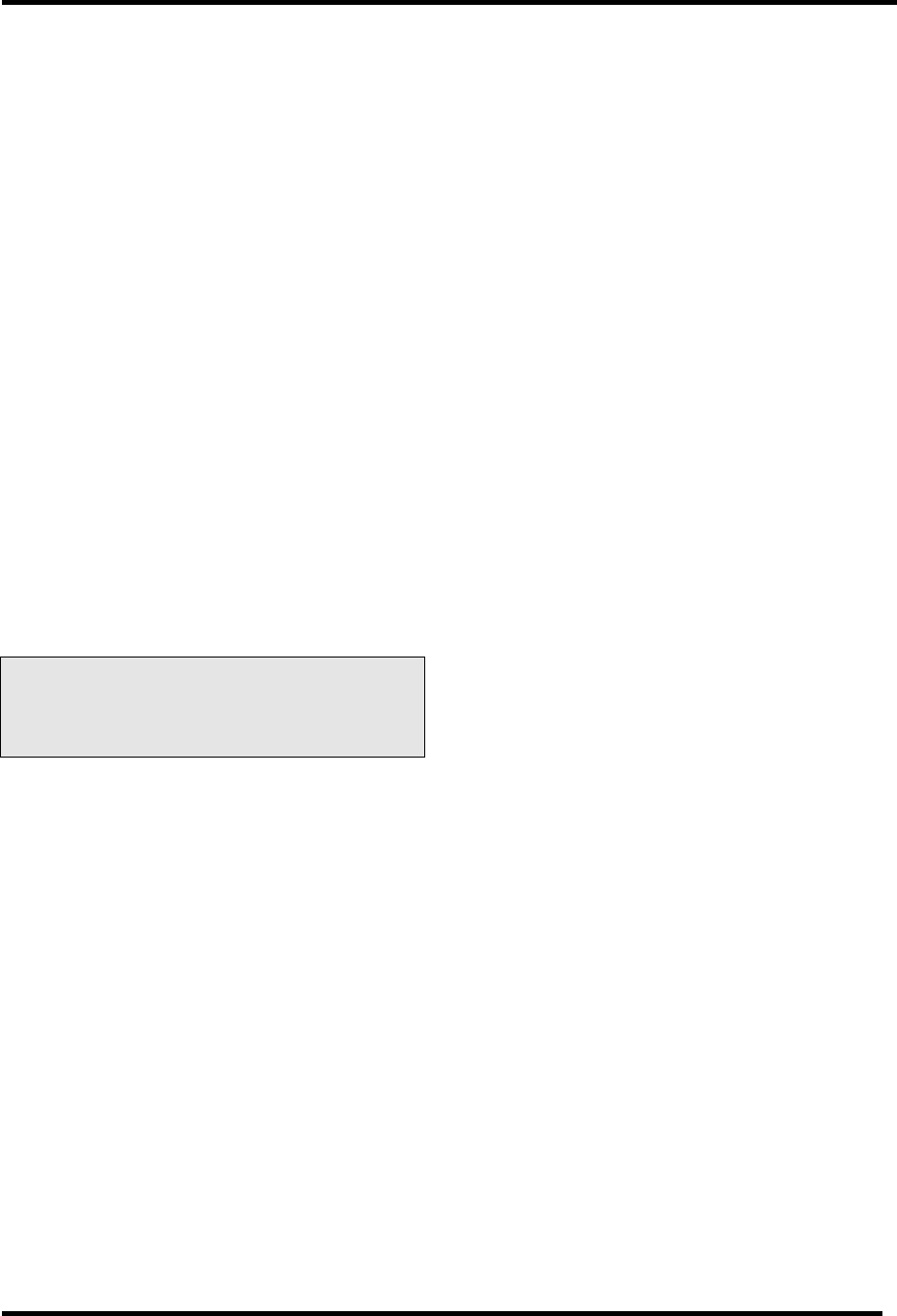
LX Series Power Amplifier Assembly Chapter 3, Site Considerations,
Installation and Setup Procedures
LX Series, Rev. 0 3-2
sources of heat, such as personnel, and
all should be taken into account.
Now that the amount of heat that must
be removed is known, the next step is to
determine how to accomplish this. The
options are air conditioning, ventilation,
or a combination of the two. Air
conditioning is always the preferred
method and is the only way to create
anything close to an ideal environment.
Ventilation will work quite well if the
ambient air temperature is below 100° F,
or about 38° C, and the humidity is kept
at a reasonable level. In addition, the air
stream must be adequately filtered to
ensure that no airborne particulates of
any kind will be carried into the
transmitter. The combination of air
conditioning for summer and ventilation
during the cooler months is acceptable
when the proper cooling cannot be
obtained through the use of ventilation
alone and using air conditioning
throughout the year is not feasible.
Caution: The use of air conditioning
and ventilation simultaneously is not
recommended. This can cause
condensation in the transmitters.
The following precautions should be
observed regarding air conditioning
systems:
1. Air conditioners have an ARI
nominal cooling capacity rating. In
selecting an air conditioner, do not
assume that this number can be
equated to the requirements of
the site. Make certain that the
contractor uses the actual
conditions that are to be
maintained at the site in
determining the size of the air
conditioning unit. With the desired
conditioned room temperature
under 80° F, the unit must be
derated, possibly by a substantial
amount.
2. Do not have the air conditioner
blowing directly onto the
transmitter. Under certain
conditions, condensation may
occur on, or worse in, the
transmitter.
3. Do not separate the front of the
transmitter from the back with the
thought of air conditioning only
the front of the unit. Cooling air is
drawn in at the front of all
transmitters and in the front and
back of others. Any attempt to
separate the front of the
transmitter from the rear of the
unit will adversely affect the flow
of cooling air.
4. Interlocking the transmitter with
the air conditioner is
recommended to keep the
transmitter from operating without
the necessary cooling.
5. The periodic cleaning of all filters
is a must.
When using ventilation alone, the
following general statements apply:
1. The blower, with attendant filters,
should be on the inlet, thereby
pressurizing the room and
preventing dirt from entering the
transmitter.
2. The inlet and outlet vents should
be on the same side of the
building, preferably the leeward
side. As a result, the pressure
differential created by wind will be
minimized. Only the outlet vent
may be released through the roof.
3. The inlet and outlet vents should
be screened with 1/8-inch
hardware cloth (preferred) or
galvanized hardware cloth
(acceptable).
4. Cooling air should enter the room
as low as practical but in no case

LX Series Power Amplifier Assembly Chapter 3, Site Considerations,
Installation and Setup Procedures
LX Series, Rev. 0 3-3
higher than four feet above the
floor. The inlet must be located
where dirt, leaves, snow, etc., will
not be carried in with the cooling
air.
5. The exhaust should be located as
high as possible. Some ducting is
usually required to insure the
complete flushing of heated air
with no stagnant areas.
6. The filter area must be large
enough to insure a maximum air
velocity of 300 feet per minute
through the filter. This is not a
conservative number but a never-
exceed number. In a dusty or
remote location, this number
should be reduced to 150 CFM.
7. The inlet and outlet(s) must have
automatic dampers that close any
time the ventilation blower is off.
8. In those cases in which
transmitters are regularly off for a
portion of each day, a
temperature-differential sensor
that controls a small heater must
be installed. This sensor will
monitor inside and outside
temperatures simultaneously. If
the inside temperature falls to
within 5° F of the outside
temperature, the heater will come
on. This will prevent condensation
when the ventilation blower comes
on and should be used even in the
summer.
9. A controlled-air bypass system
must be installed to prevent the
temperature in the room from
falling below 40° F during
transmitter operation.
10. The blower should have two
speeds, which are thermostatically
controlled, and be interlocked with
the transmitter.
11. The blower on high speed must be
capable of moving the required
volume of air into a half inch of
water pressure at the required
elevation. The free air delivery
method must not be used.
12. Regular maintenance of the filters,
if used, can not be
overemphasized.
13. Above 4000 feet, for external
venting, the air vent on the
cabinet top must be increased to
an 8-inch diameter for a 1-kW
transmitter and to a 10-inch
diameter for 5-kW and 6-kW
transmitters. An equivalent
rectangular duct may be used but,
in all cases, the outlet must be
increased by 50% through the
outlet screen.
14. It is recommended that a site plan
be submitted to Axcera for
comments before installation
begins.
In calculating the blower requirements,
filter size, and exhaust size, if the total
load is known in watts, 2000 CFM into ½
inch of water will be required for each
5000 watts. If the load is known in BTUs,
2000 CFM into ½ inch of water will be
required for each 17,000 BTUs. The inlet
filter must be a minimum of seven
square feet, larger for dusty and remote
locations, for each 5000 watts or 17,000
BTUs. The exhaust must be at least four
square feet at the exhaust screen for
each 5000 watts or 17,000 BTUs.
The information presented in this section
is intended to serve only as a general
guide and may need to be modified for
unusually severe conditions. A
combination of air conditioning and
ventilation should not be difficult to
design (see Figure 3-1).
System interlocking and thermostat
settings should be reviewed with Axcera.
As with any equipment installation, it is
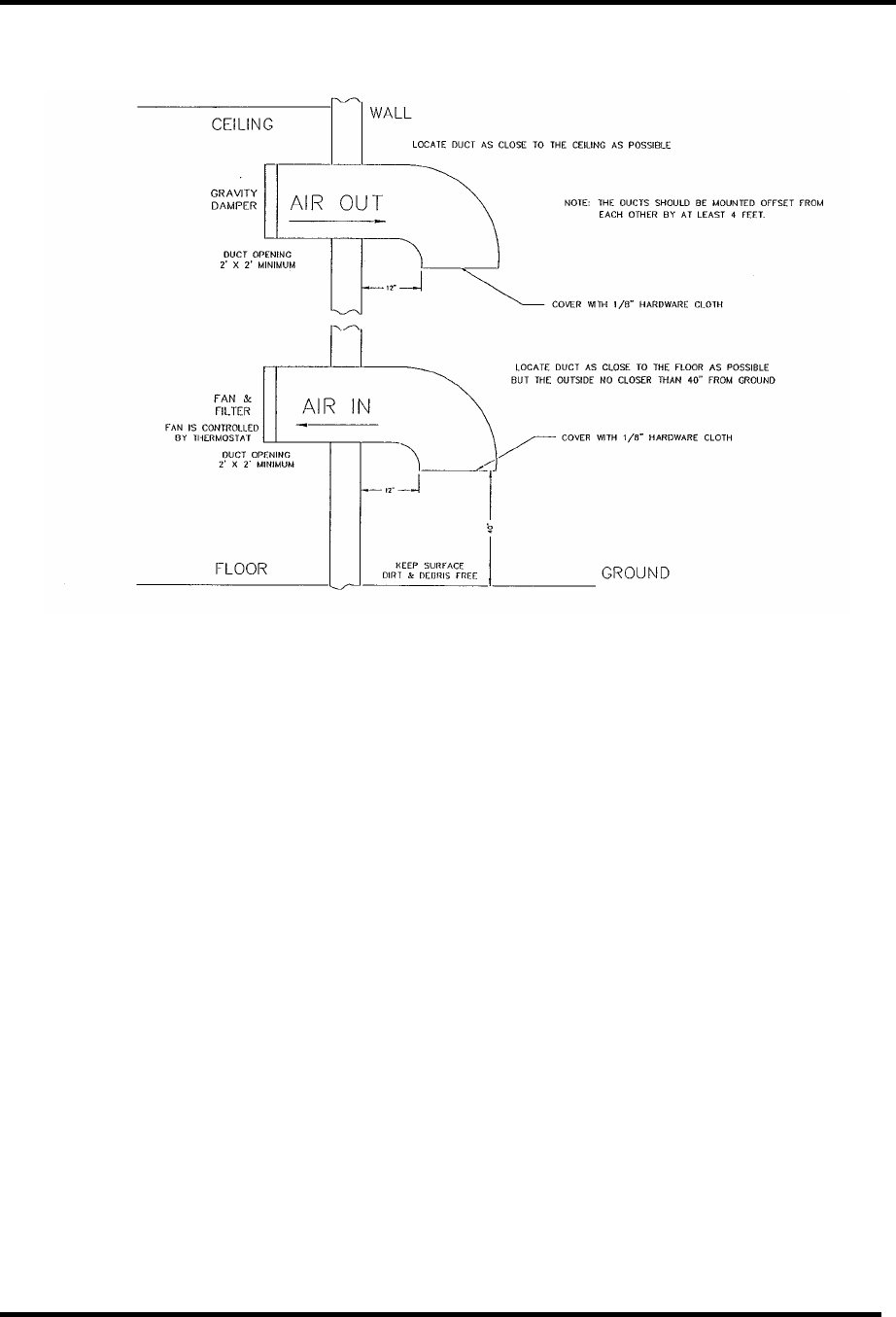
LX Series Power Amplifier Assembly Chapter 3, Site Considerations,
Installation and Setup Procedures
LX Series, Rev. 0 3-4
always good practice to consult the
manufacturer when questions arise.
Axcera can be contacted at (724) 873-
8100.
Figure 3-1. 1 kW Minimum Ventilation Configuration
3.2 Unpacking the Chassis
w/modules, bandpass and optional
trap filters
Thoroughly inspect the chassis with
modules and all other materials upon
their arrival. Axcera certifies that upon
leaving our facility the equipment was
undamaged and in proper working order.
The shipping containers should be
inspected for obvious damage that
indicates rough handling.
Remove the chassis and modules, along
with bandpass filter and optional trap
Filter, from the crates and boxes.
Check for dents and scratches or broken
connectors, switches, display, or
connectors. Any claims against in-transit
damage should be directed to the carrier.
Inform Axcera as to the extent of any
damage as soon as possible.
The modules are mounted to the chassis
assembly with slides that are on the top
and the bottom of the modules. There
are two thumb screws on the front panel
that hold each of the modules in place.
3.3 Installing the Chassis w/modules
and filters
The exciter/driver and power amplifier
chassis assemblies are made to mount in
a standard 19” rack. The chassis
assemblies mount using the four #10
clearance mounting holes on the ends.
The chassis should be positioned; to
provide adequate air intake into the front
and the air exhaust of the fan in the rear;
the ability to slide the modules out for
replacement purposes; the installation of
the bandpass filter; optional trap filter;
the coupler assembly; and output
transmission line. The chassis or cabinet
in which it is mounted should be
grounded using copper strapping
material.
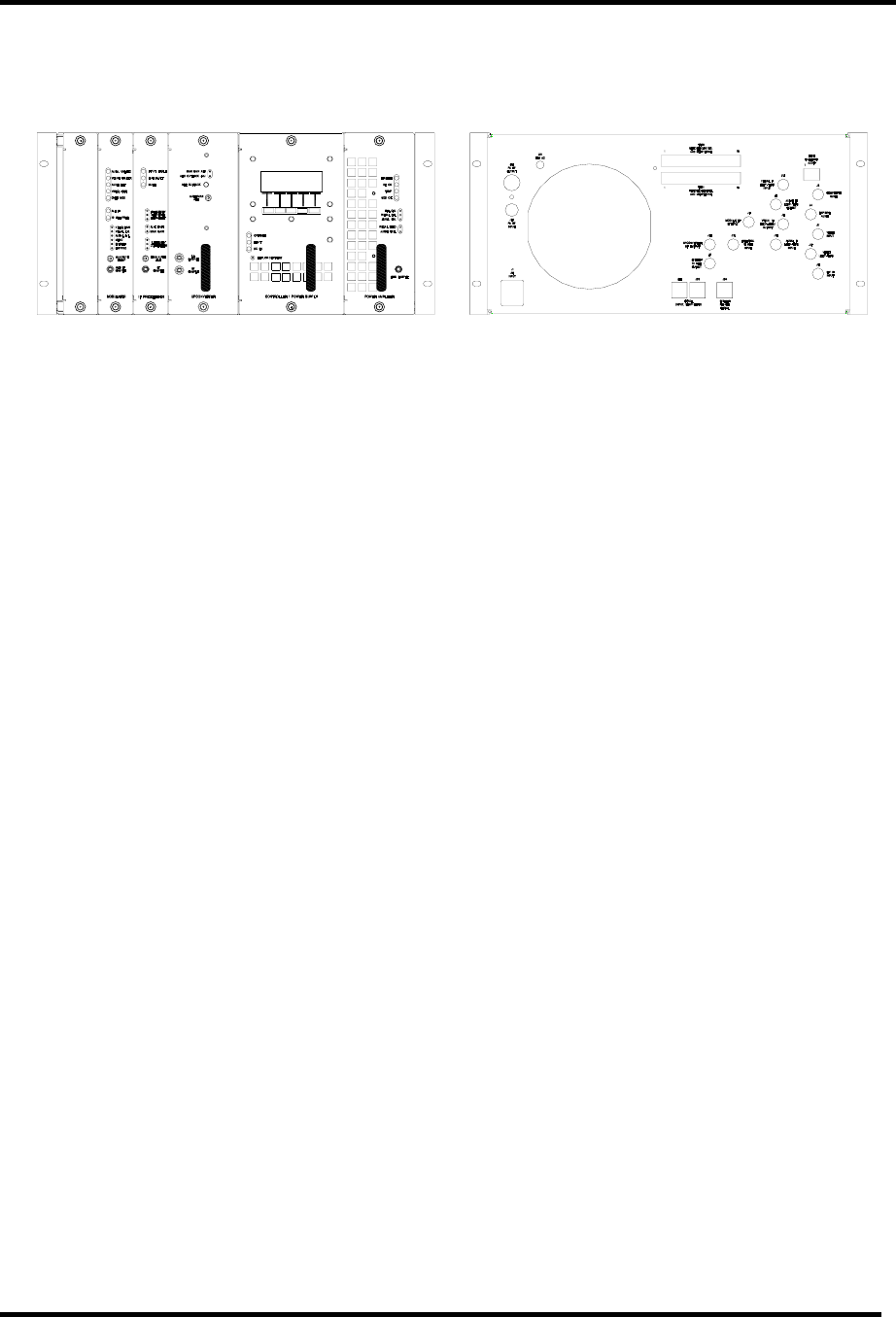
LX Series Power Amplifier Assembly Chapter 3, Site Considerations,
Installation and Setup Procedures
LX Series, Rev. 0 3-5
NOTE: To pull out any power amplifier
module for replacement purposes, the
input and output coaxial cables must first
be removed from the rear of the chassis
assembly.
Figure 3-2. Front and Rear View Reconnection Drawing
Connect the transmission line for the
antenna system to the output of the
optional trap filter. A BNC sample jack of
the output on the trap filter can be used
for test purpose.
3.4 AC Input
The Driver Assembly requires one AC
outlet in which to plug, of 220 VAC @ 5
amps and each 500 Watt power amplifier
assembly needs one AC outlet in which to
plug, of 220 VAC @ 17 amps maximum.
One 500 Watt power amplifier assembly
consists of two PA assemblies and one
power supply assembly.
This completes the unpacking and
installation of the LX Series UHF
television transmitter. Refer to the setup
and operation procedures that follow
before applying power to the transmitter.
3.5 Setup and Operation
Initially, the transmitter should be turned
on with the RF output at the directional
coupler terminated into a dummy load of
at least the rated power of the
transmitter. If a load is not available,
check that the output of the directional
coupler is connected to the antenna for
your system.
3.5.1 Input Connections
The input connections to the transmitter
are to the rear of the exciter/driver
chassis assembly for the transmitter or to
the receiver tray in a translator.
Refer to the tables and description that
follows for detailed information on the
input connections.
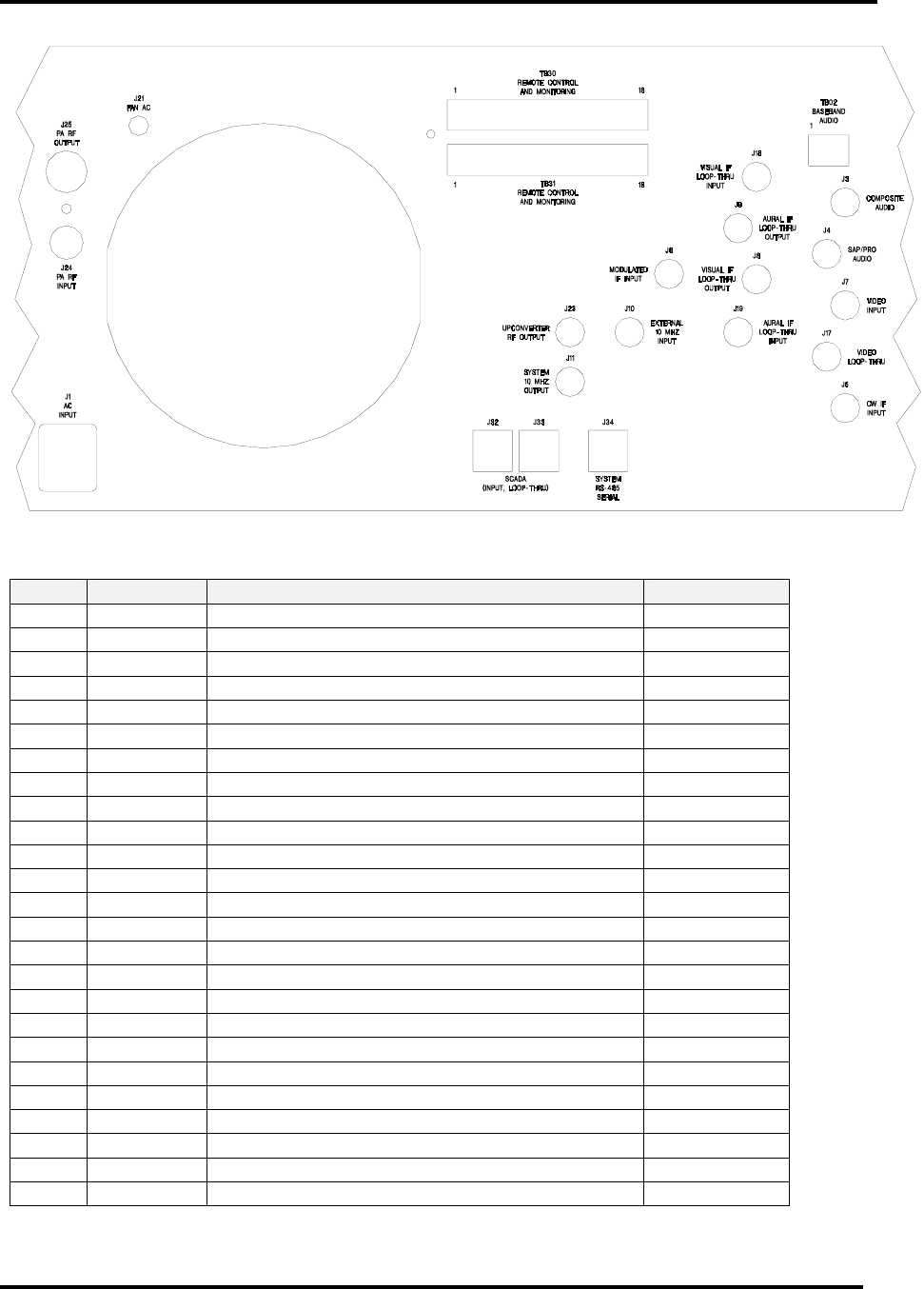
LX Series Power Amplifier Assembly Chapter 3, Site Considerations,
Installation and Setup Procedures
LX Series, Rev. 0 3-6
Figure 3-3: Rear View of LX Series Transmitter
Table 3-1: Rear Chassis Connections for the LX Series Transmitter.
Port Type Function Ohm
J1 IEC AC Input
TB02 Term Base Band Audio Input 600
J3 BNC Composite Audio Input 75
J4 BNC SAP / PRO Audio Input 75
J5 BNC CW IF Input 50
J6 BNC Modulated IF Input 50
J7 BNC Video Input (Isolated) 75
J8 BNC Visual IF Loop-Thru Output 50
J9 BNC Aural IF Loop-Thru Output 50
J10 BNC 10 MHz Reference Input 50
J11 BNC 10 MHz Reference Output 50
J17 BNC Video Loop-Thru (Isolated) 75
J18 BNC Visual IF Loop-Thru Input 50
J19 BNC Aural IF Loop-Thru Input 50
J23 BNC Upconverter RF Output 50
J24 BNC Power Amplifier RF Input 50
J25 N Power Amplifier RF Output 50
TB30 Term Remote Control & Monitoring
TB31 Term Remote Control & Monitoring
J32 RJ-45 SCADA (Input / Loop-Thru) CAT5
J33 RJ-45 SCADA (Input / Loop-Thru) CAT5
J34 RJ-45 System RS-485 Serial CAT5
J1
J24
J25 J21
TB30
TB31
J32 J34
J33
J11 J10
J23
J6
J5
J19
J18
TB02
J3
J4
J7
J17
J8
J9
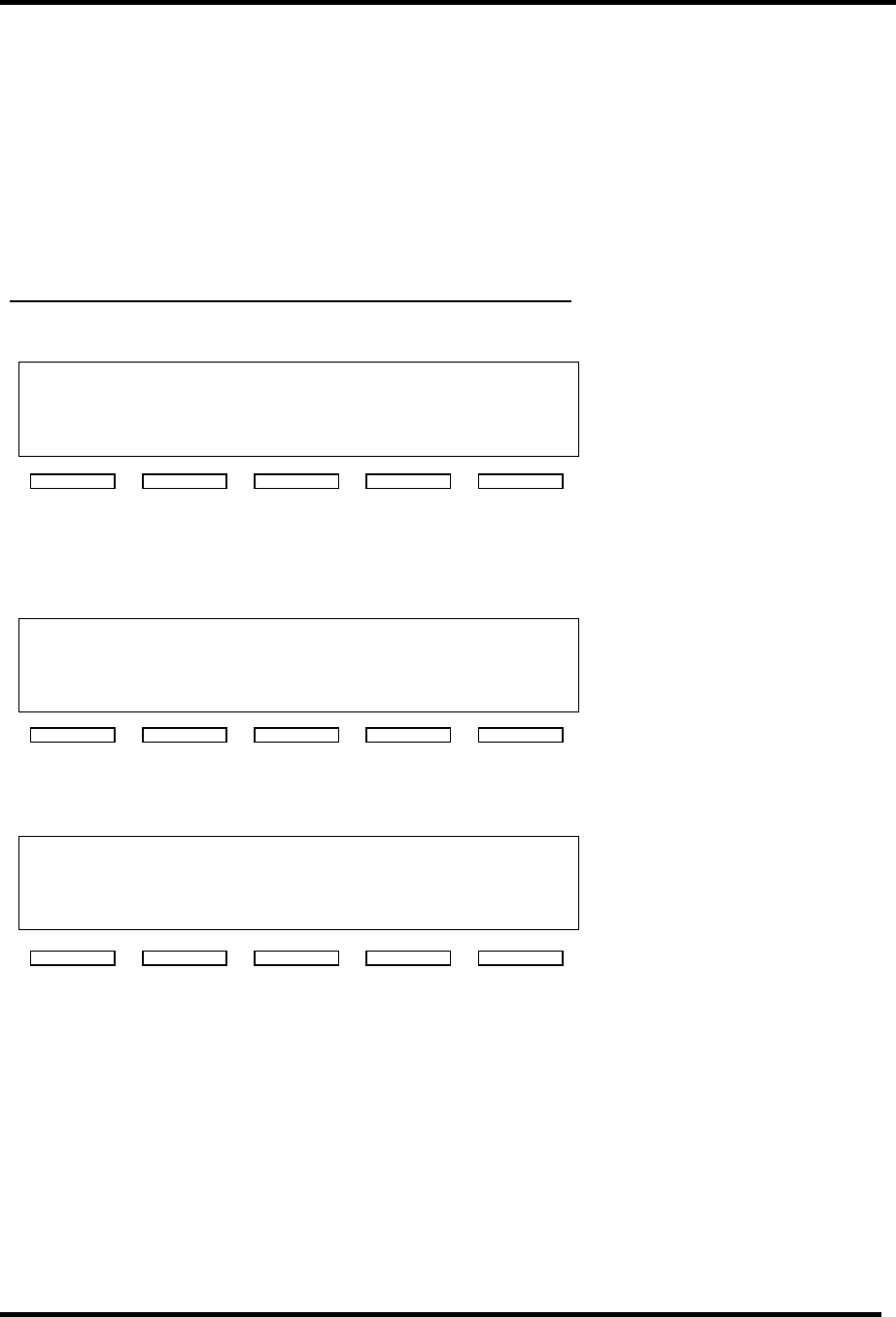
LX Series Power Amplifier Assembly Chapter 3, Site Considerations,
Installation and Setup Procedures
LX Series, Rev. 0 3-7
3.5.2 Front Panel Screens for the
Exciter/Amplifier Chassis Assembly
A 4 x 20 display located on the front of
the Control & Monitoring/Power Supply
Module is used in the LX Series
transmitter for control of the operation
and display of the operating parameters
of the transmitter. Below are the display
screens for the system. The ↑ and ↓
characters are special characters used to
navigate up or down through the menu
screens. Display text flashes on discrete
fault conditions for all screens that
display a fault condition.
When the transmitter is in operate mode,
the STB menu appears. When the
transmitter is in standby mode, the OPR
menu appears.
Display Menu Screens for the LX Series Transmitter
Table 3-2: Menu 01 - Splash Screen #1
A X C E R A
1 0 3 F R E E D O M D R I V E
L A W
R E N C E , P A . 1 5 0 5 5
( 7 2 4 ) 8 7 3 - 8 1 0 0
This is the first of the two transmitter splash screens that is shown for the first few
seconds after reset.
Table 3-3: Menu 02- Splash Screen #2
P I O N E E R L D U 1 0 0 A T D
C O D E V E R S I O N 1 . 0
F I R M W A R E 1 3 0 2 1 6 4
S C A D A A D D R E S S 5
This is the second of the two transmitter splash screens
Table 3-4: Menu 10 - Main Screen
V I S U A L P W R 1 0 0 %
A U R A L P W R 1 0 0 %
R E F L E C T E D P W R 1 . 0 %
↑
↓ S T B
This is the default main screen of the transmitter. When the transmitter is in operate,
the 'STB' characters appear allowing an operator to place the transmitter in STAND-BY.
When the transmitter is in standby the 'STB' characters are replaced with 'OPR' and an
operator can place the transmitter into OPERATE by pressing the right most switch on the
front panel display. If the ↓ key is activated the system changes to Menu 11, go to Menu
11. If the ↑ key is activated the system displays to Menu 13, go to Menu 13.
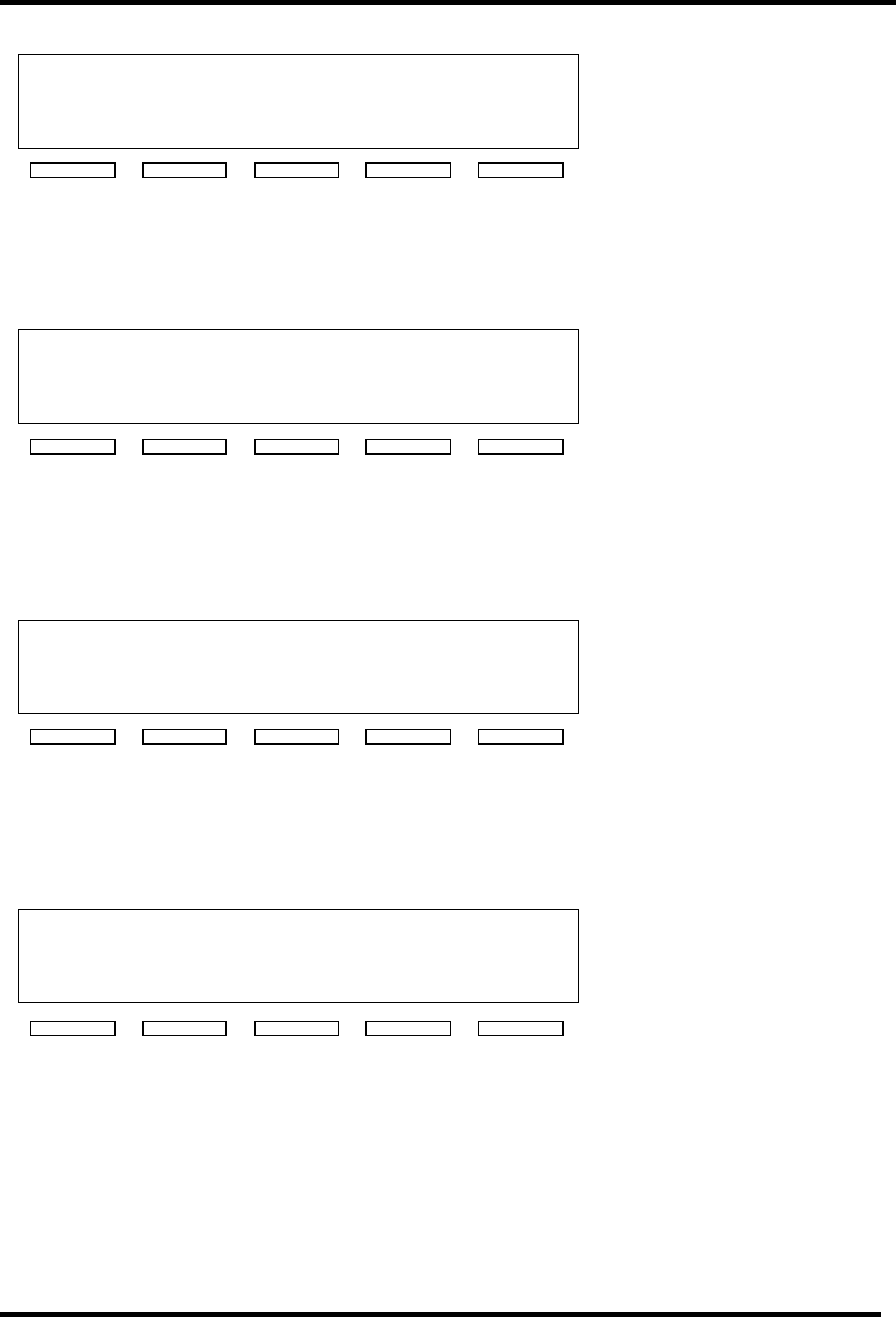
LX Series Power Amplifier Assembly Chapter 3, Site Considerations,
Installation and Setup Procedures
LX Series, Rev. 0 3-8
Table 3-5: Menu 11 - Error List Access Screen
S Y S T E M E R R O R S
6
E R R O R L I S T D I S P L A Y
↑
↓ E N T S T B
This screen of the transmitter shows the current number of errors and provides operator
access to view the error list. This is the entry point to Menu 20. If ENT is pushed, go to
Menu 20. If the ↓ key is activated the system changes to Menu 12, go to Menu 12. If the
↑ key is activated the system returns to Menu 10, go to Menu 10.
Table 3-6: Menu 12 - Transmitter Device Data Access Screen
T R A N S M I T T E R D E T A I L S
↑
↓ E N T S T B
This screen of the transmitter allows access to various parameters of the transmitter
system. This is the entry point to Menu 30. If ENT is pushed, go to Menu 30. If the ↓
key is activated the system changes to Menu 13, go to Menu 13. If the ↑ key is activated
the system returns to Menu 11, go to Menu 11.
Table 3-7: Menu 13 - Transmitter Configuration Access Screen
T R A N S M I T T E R S E T - U P
↑
↓ E N T S T B
This screen of the transmitter allows access to various software setting of the transmitter
system. This is the entry point to Menu 40. If ENT is pushed, go to Menu 40. If the ↓
key is activated the system returns to Menu 10, go to Menu 10. If the ↑ key is activated
the system returns to Menu 12, go to Menu 12.
Table 3-8: Menu 20 - Error List Display Screen
S Y S T E M E R R O R S 1 / 6
U P C O N V E R T E R M O D U L E
I N T E R L O C K F A U L T
↑
↓ C L R E S C
This screen of the transmitter allows access to system faults. Fault logging is stored in
non-volatile memory. The transmitter's operating state can not be changed in this
screen. The 'CLR' switch is used to clear previously detected faults that are no longer
active. The ↑ key and ↓ key allow an operator to scroll through the list of system errors
that have occurred. The ESC switch is used to leave this screen.
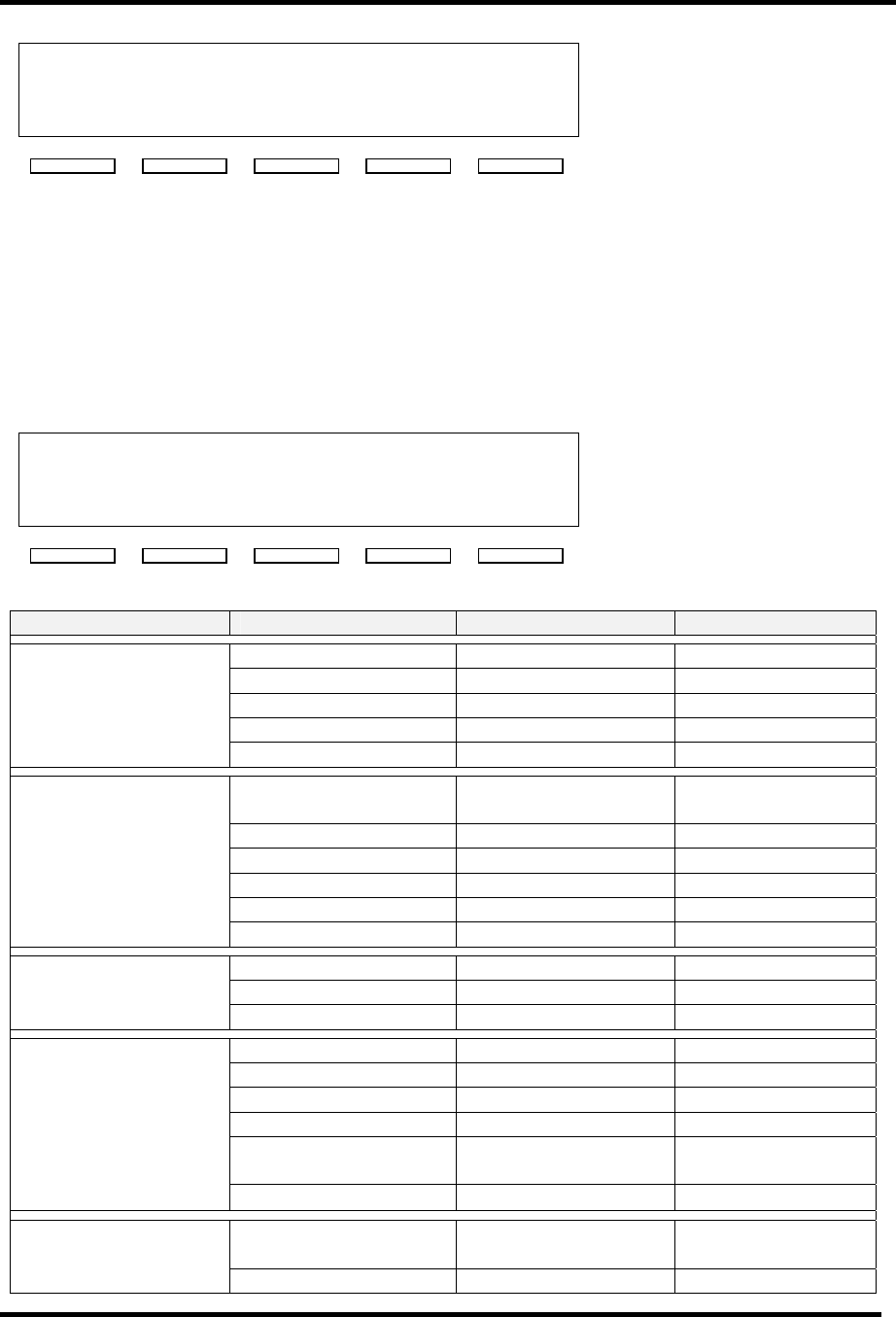
LX Series Power Amplifier Assembly Chapter 3, Site Considerations,
Installation and Setup Procedures
LX Series, Rev. 0 3-9
Table 3-9: Menu 30 - Transmitter Device Details Screen
S Y S T E M D E T A I L S
X M T R I N O P E R A T E M O D E
P O W E R S U P P L Y : O K
↑
↓ E S C
This screen of the transmitter allows access to the transmitter parameters of installed
devices. The system is configured to know which devices are present. Current values for
all installed devices are shown. If a module is not installed, only a "MODULE NOT
PRESENT" message will be displayed. The ↑ and ↓ arrows scroll through the different
parameters of each device as shown in table 3-11. Each System Component is a
different screen. One IF Processor or the other will be programmed for your system. One
Power Amplifier or the other will be programmed for your system. External Amplifier will
only be used in high power transmitters.
Table 3-10: Menu 30-1 – System Details Screen
S Y S T E M D E T A I L S
0 % 0 % 0 . 0 %
V I S U A L A U R U A L R E F L
↑
↓ E S C
Table 3-11: Transmitter Device Parameters Detail Screens
System Component Parameter Normal Faulted (Blinking)
PLL CIRCUIT LOCKED UNLOCKED
OUTPUT LEVEL 0 - 200 IRE N/A
AURAL DEVIATION 0 - 125 kHz N/A
CW INPUT PRESENT NOT USED
Modulator Details STATION ID SEND soft key N/A
INPUT SIGNAL
STATE OK FAULT
MODULATION OK FAULT
INPUT IF MODULATOR or J6 N/A
DLC LEVEL 0 - 5.00 V N/A
ALC LEVEL 0 - 5.00 V N/A IF Processor Details
(Analog Systems) ALC MODE AUTO or MANUAL N/A
ALC LEVEL 0 - 5.00 V N/A
ALC MODE AUTO or MANUAL N/A
(OR)
IF Processor Details
(Digital Systems) DLC LEVEL 0 - 5.00 V N/A
PLL CIRCUIT LOCKED FAULT
AFC LEVEL 0 - 5.00 V N/A
AGC 1 LEVEL 0 - 5.00 V N/A
AGC 2 LEVEL 0 - 5.00 V N/A
EX. 10 MHz
PRESENT or NOT
USED N/A
Upconverter Details LO FREQ xxx.xxx MHz N/A
POWER SUPPLY
STATE ON or OFF N/A
Driver PA Details
±12V SUPPLY OK or OFF FAULT
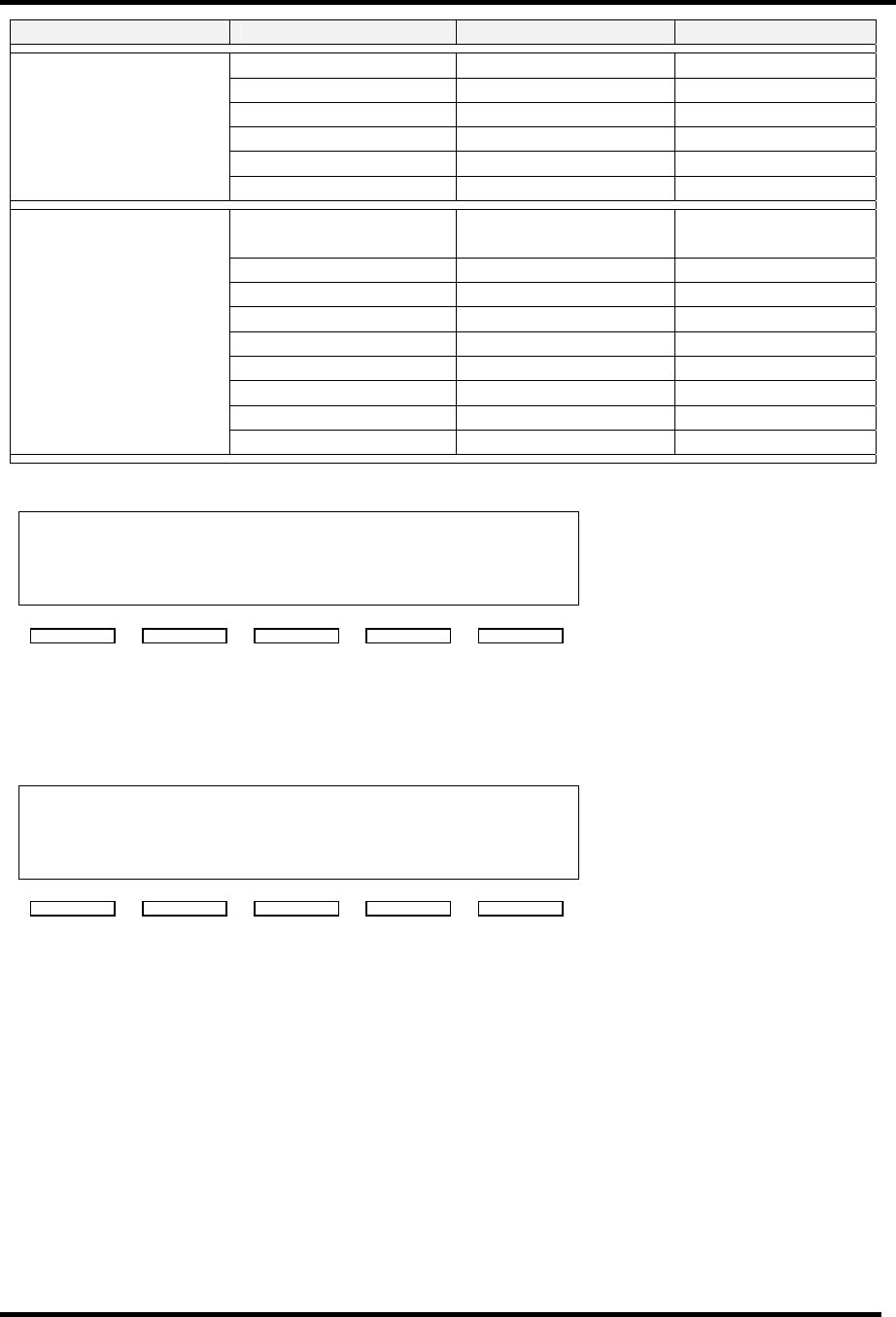
LX Series Power Amplifier Assembly Chapter 3, Site Considerations,
Installation and Setup Procedures
LX Series, Rev. 0 3-10
System Component Parameter Normal Faulted (Blinking)
FORWARD POWER xxx% xxx%
REFLECTED POWER xxx% xxx%
AMP 1 CURRENT xx.xA xx.xA
AMP 2 CURRENT xx.xA xx.xA
TEMPERATURE xxC xxC
CODE VERSION x.x N/A
POWER SUPPLY
STATE ON or OFF N/A
±12V SUPPLY OK or OFF FAULT
FORWARD POWER xxx% xxx%
REFLECTED POWER xxx% xxx%
AMP CURRENT 1 xx.xA xx.xA
AMP CURRENT 2 xx.xA xx.xA
AMP CURRENT 3 xx.xA xx.xA
AMP TEMPERATURE xxC xxC
Ext. Power Amplifier
Modules Details
(Only in high power
systems) CODE VERSION x.x N/A
Table 3-12: Menu 40 - Transmitter Set-up: Power Raise/Lower Screen
T R A N S M I T T E R S E T - U P
0 1 P O W E R R A I S E / L O W E R
S E T T I N G 1 0 0 %
↑
↓ ( + ) E S C ( - )
This screen of the transmitter is the first of several that allows access to transmitter set-
up parameters. When + is selected, the Power will increase. When - is selected, the
Power will decrease.
Table 3-13: Menu 40-1 - Transmitter Set-up: Model Select Screen
T R A N S M I T T E R S E T - U P
0 2 T R A N S M I T T E R M O D E L
N U M B E R L U 0 1 0 0 A T
↑
↓ ( + ) E S C ( - )
This screen is used to specify which components are expected to be part of the system.
By specifying the model number, the transmitter control firmware knows which
components should be installed and it will be able to display faults for components that
are not properly responding to system commands.
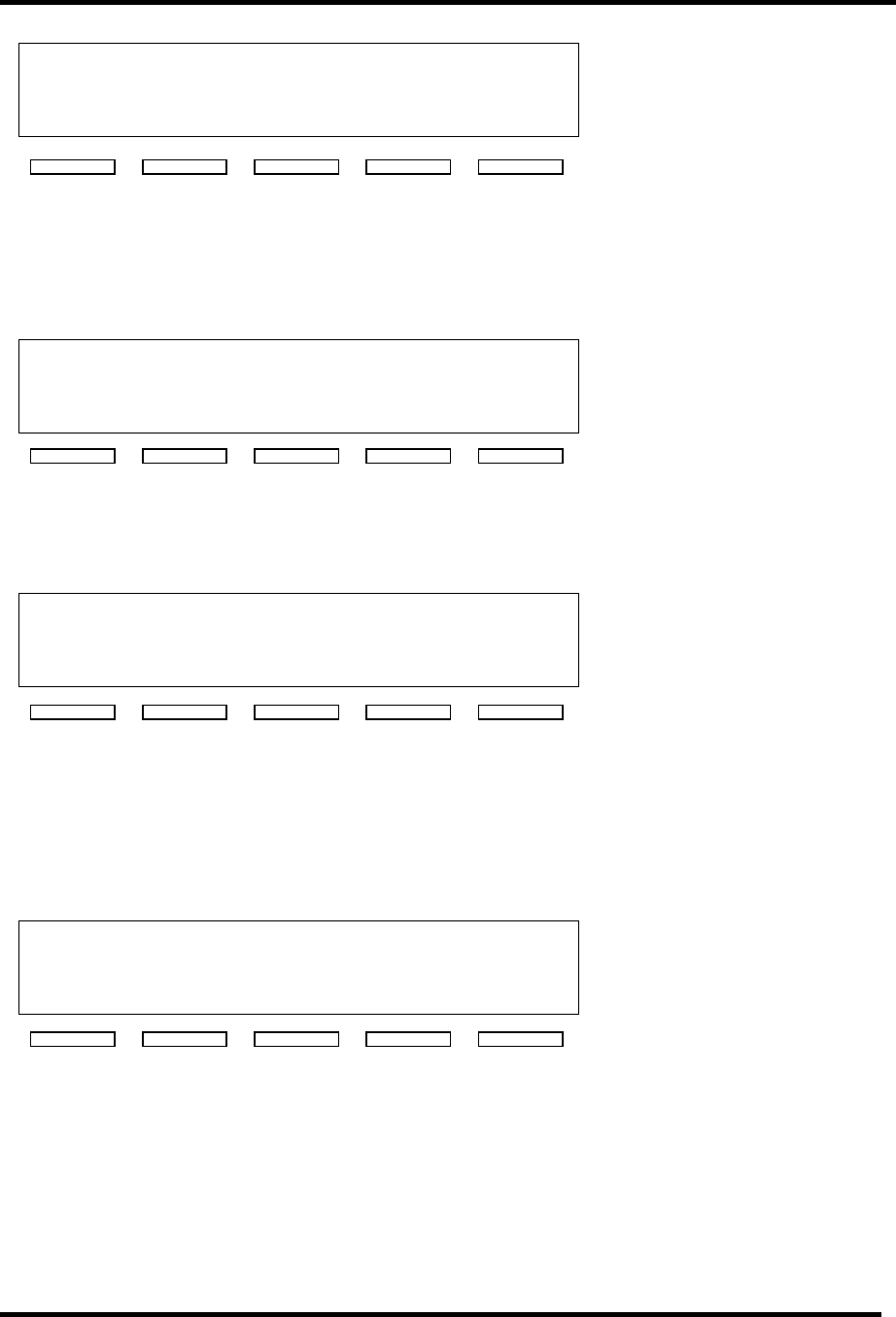
LX Series Power Amplifier Assembly Chapter 3, Site Considerations,
Installation and Setup Procedures
LX Series, Rev. 0 3-11
Table 3-14: Menu 40-2 - Transmitter Set-up: Frequency Select Screen
T R A N S M I T T E R S E T - U P
0 3
F R E Q U E N C Y S E L E C T
T A B L E O R C U S T O M
↑
↓ ( + ) E S C ( - )
This screen of the transmitter is allows access to transmitter frequency set-up
parameters. The choices of this screen are 'TABLE' or 'CUSTOM'. When table is selected,
the next menu will be used to select the desired operating frequency. When custom is
selected, the next menu is used to select a specific operating frequency.
Table 3-15: Menu 40-3 - Transmitter Set-up: Frequency Table Select Screen
T R A N S M I T T E R S E T - U P
0 3 F R E Q U E N C Y S E L E C T
C H 2 0 5 0 6 - 5 1 2 M H z
↑
↓ ( + ) E S C ( - )
The choices of this screen are from the standard UHF / VHF tables. + and - change the
desired value of the transmitter. Any change to frequency is immediately set to the LO /
Upconverter Frequency Synthesizer PLL circuit.
Table 3-16: Menu 40-4 - Transmitter Set-up: IF Frequency Screen
T R A N S M I T T E R S E T - U P
0 3 I F F R E Q U E N C Y
I N P U T 4 4 . 0 0 M H z
↑
↓ ( + ) E S C >
This screen is used to specify the IF Input frequency. This value plus the desired channel
value is used to calculated the desired LO frequency. + is used to increase the selected
value from 0 to 9. The > key is used to select from each of the different fields that make
up the desired frequency. Any change to frequency is immediately set to the LO /
Upconverter Frequency Synthesizer PLL circuit.
Table 3-17: Menu 40-5 - Transmitter Set-up: Custom Frequency Select Screen
T R A N S M I T T E R S E T - U P
0 3 F R E Q U E N C Y S E L E C T
0 5 0 9 . 0 0 0
M H z
↑
↓ ( + ) E S C ( - )
This screen is used to specify the operating frequency to an exact value. + is used to
increase the selected value from 0 to 9. The > key is used to select from each of the
different fields that make up the desired frequency. Any change to frequency is
immediately set to the LO / Upconverter Frequency Synthesizer PLL circuit.
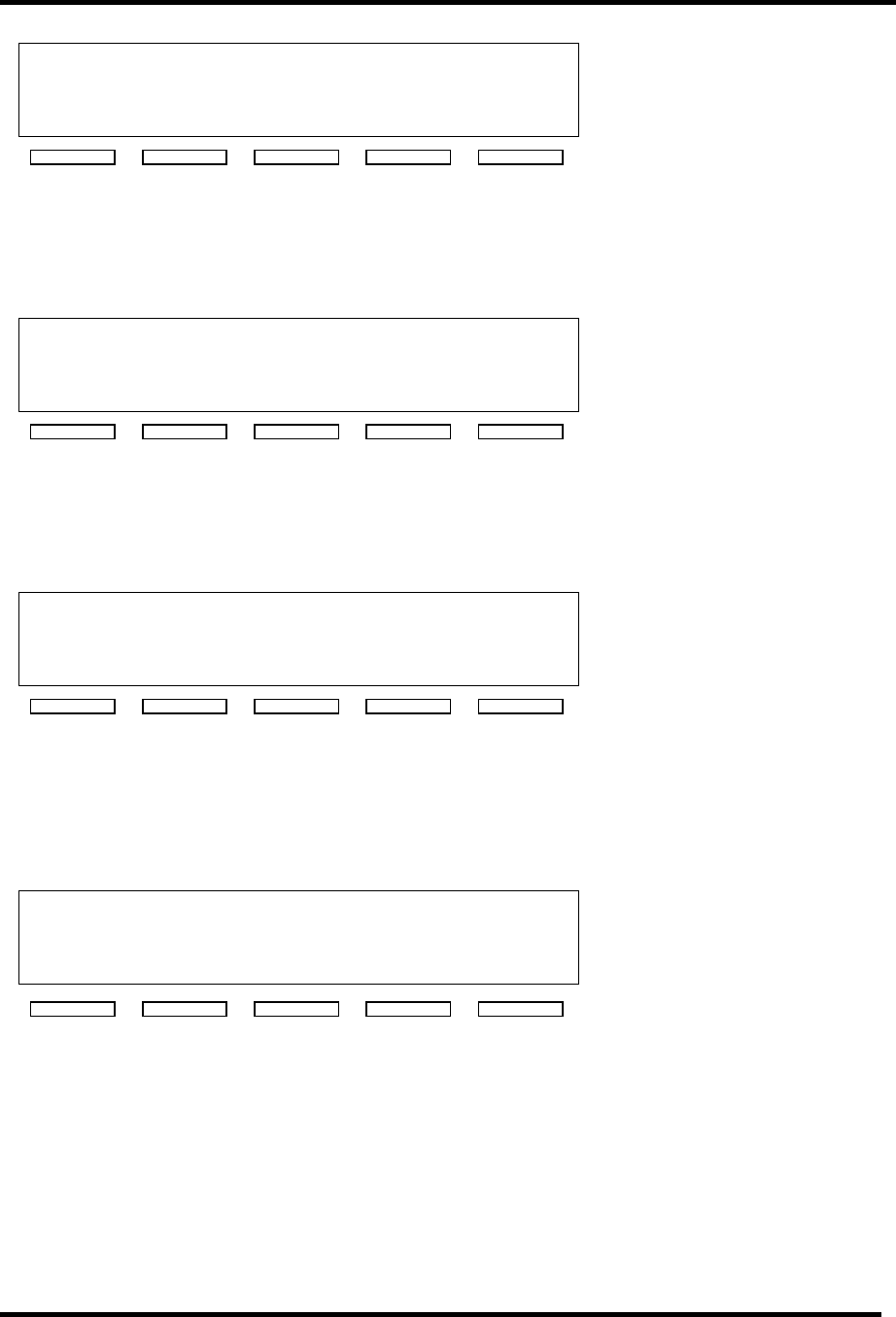
LX Series Power Amplifier Assembly Chapter 3, Site Considerations,
Installation and Setup Procedures
LX Series, Rev. 0 3-12
Table 3-18: Menu 40-6 - Transmitter Set-up: Serial Address Screen
T R A N S M I T T E R S E T - U P
0 4 S E R I A L A D D R E S S 5
↑
↓ ( + ) E S C ( - )
This screen allows the user to set the serial address of the transmitter. The default
address is 5. This value and all other set-up parameters, are stored in non-volatile
memory.
Table 3-19: Menu 40-7 - Transmitter Set-up: Station ID Screen
T R A N S M I T T E R S E T - U P
0 5 M O D U L A T E D S I G N A L
S T A T I O N I D 0 0 0 0 0
↑
↓ ( + ) E S C ( - )
This screen allows the user to set the serial address of the transmitter. The default
address is 5. This value and all other set-up parameters, are stored in non-volatile
memory.
Table 3-20: Menu 40-8 - Transmitter Set-up: System Visual Power Calibration
T R A N S M I T T E R S E T - U P
0 6 S Y S T E M C A L I B R A T E
V I S U A L P O W E R 1 0 0 %
↑
↓ ( + ) E S C ( - )
This screen is used to adjust the calibration of the system's visual power. A symbol
placed under the '6' character is used to show minor changes in the calibration value.
When the calibration value is at full value, the character will be full black. As the value
decreases, the character pixels are gradually turned off.
Table 3-21: Menu 40-9 - Transmitter Set-up: System Aural Power Calibration
T R A N S M I T T E R S E T - U P
0 6
S Y S T E M C A L I B R A T E
A U R A L P W R 1 0 0 %
↑
↓ ( + ) E S C ( - )
This screen is used to adjust the calibration of the system's aural forward power. A
symbol as on the previous screen is under the '6' character on this screen.
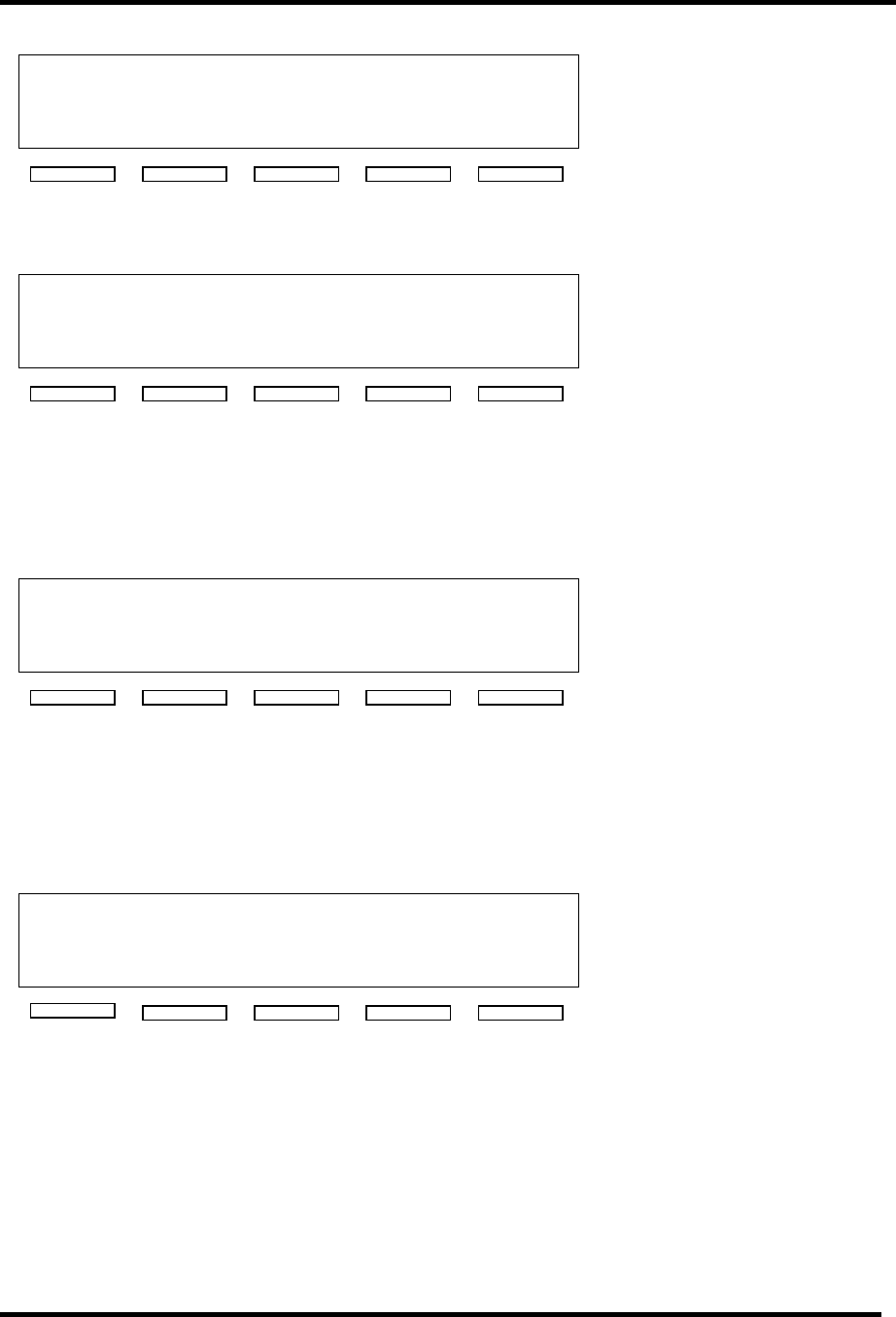
LX Series Power Amplifier Assembly Chapter 3, Site Considerations,
Installation and Setup Procedures
LX Series, Rev. 0 3-13
Table 3-22: Menu 40-10 - Transmitter Set-up: System Reflected Power Calibration
T R A N S M I T T E R S E T - U P
0 6 S Y S T E M C A L I B R A T E
R E F L E C T P W R X . X %
↑
↓ ( + ) E S C ( - )
This screen is used to adjust the calibration of the system's reflected power.
Table 3-23: Menu 40-11 - Transmitter Set-up: Forward Power Fault Threshold Screen
T R A N S M I T T E R S E T - U P
0 7 M I N I M U M F O R W A R D
P O WE R F A U L T 5 0 %
↑
↓ ( + ) E S C ( - )
This screen is used to set the minimum forward power fault threshold. When the
transmitter is operating, it must operate above this value otherwise the system will shut
down with fault for 5 minutes. If after five minutes the fault is not fixed, the transmitter
will enable, measure power less than this value and again shut down for five minutes.
Table 3-24: Menu 40-12 - Transmitter Set-up: Reflected Power Fault Threshold
T R A N S M I T T E R S E T - U P
0 8 M A X I M U M R E F L E C T E D
P O WE R F A U L T 1 0 %
↑
↓ ( + ) E S C ( - )
This screen is used to set the maximum reflected power fault threshold. When the
transmitter is operating, it must not operate above this value otherwise the system will
shut down with fault for 5 minutes. If after five minutes the fault is not fixed, the
transmitter will enable, measure power above this value and again shut down for five
minutes.
Table 3-25: Menu 40-13 - Transmitter Set-up: Remote Commands Control
T R A N S M I T T E R S E T - U P
0 9 R E M O T E C O N T R O L
C O M M A N D S A C C E P T E D
↑
↓ ( + ) E S C ( - )
This screen is used to allow or deny the use of remote control commands. When
disabled, remote commands are not used. Remote commands are commands received
either through the rear terminal blocks or through serial messages.
This completes the description of the
screens for the LX Series
exciter/amplifier chassis assembly.
If the transmitter is already connected
to the antenna, check that the output is
100%. If necessary, adjust the
amplifier power detection circuitry or
LO / Upconverter AGC settings. The
power raise / lower settings are only to
be used for temporary reductions in
power. The power set-back values do
not directly correspond to the power of
the transmitter. Setting for 50%

LX Series Power Amplifier Assembly Chapter 3, Site Considerations,
Installation and Setup Procedures
LX Series, Rev. 0 3-14
output sets a linear circuit voltage that
is controlling a non-linear power circuit.
If a problem occurred during the setup
and operation procedures, refer to
Chapter 5, Detailed Alignment
Procedures, of this manual for more
information.
3.5.3 Initial Turn On
Once the unit has been installed and
all connections have been made, the
process of turning on the equipment
can begin. First verify that AC power
is present and connected to the
transmitter. Verify all cables are
properly connected and are the correct
type. Once all of these things are
done, the unit is ready to be turned on
following the procedures below.
Turn on the main AC power source
that supplies the AC to the
transmitter. Check that the AC power
plug is connected to J1 on the rear of
the chassis assembly.
Monitor the LCD display located on the
front of the control/monitoring module
as you proceed through this section.
When the transmitter is in the operate
mode, the STB menu appears. When
in the standby mode, the OPR menu
appears. Press the NXT key after each
menu to continue through the
sequence.
MODULATOR MODULE LEDs ON
FRONT PANEL
Fault Indicators:
AUR UNLOCK: This illuminates Red
when the Aural IF PLL is unlocked.
VIS UNLOCK: This illuminates RED
when the Visual IF PLL is unlocked.
AUD OV DEV: This indicator will
illuminate Red when the audio over-
deviates the aural carrier.
VIDEO LOSS: This indicates the loss of
Video to the modulator, when Red.
OVER MOD: This illuminates Red when
the video is overmodulated.
Status Indicators:
ALT IF CW: This indicates that there is
an external IF CW signal applied to the
Modulator
10MHz PRES: This indicates the
presence of a 10 MHz reference input.
IF PROCESSOR MODULE LEDs ON
FRONT PANEL
Fault Indicators:
INPUT FAULT: This illuminates Red if
the input to the module is missing or
low.
ALC FAULT: This illuminates RED when
the needed ALC value to maintain the
output level is beyond the range of the
circuitry.
MUTE: This indicator will illuminate
Red when the transmitter is muted.
UPCONVERTER MODULE LED ON
FRONT PANEL
Fault Indicator:
AGC CUTBACK-This illuminates Red if
the required gain to produce the
desired output level is beyond the
value set by the AGC Cutback circuit.
CONTROLLER MODULE LEDs ON
FRONT PANEL
Status Indicators:
OPERATE - This illuminates Green
when transmitter is in operate.
FAULT - This illuminates Red when a
fault has occurred in the transmitter.

LX Series Power Amplifier Assembly Chapter 3, Site Considerations,
Installation and Setup Procedures
LX Series, Rev. 0 3-15
DC OK - This illuminates Green when
the DC outputs that connect to the
modules in the transmitter are
present.
POWER AMPLIFIER MODULE LEDs
ON FRONT PANEL
Status Indicators:
ENABLED - This illuminates Green
when the PA is in operate.
DC OK - This illuminates Green when
the DC inputs to the PA module are
present.
TEMP - This illuminates Green when
the temperature of the heatsink in the
PA is below 78°C.
MOD OK - This illuminates Green when
the PA module is operating and has no
faults.
This completes the Installation, Set Up
and Turn On of the Transmitter.